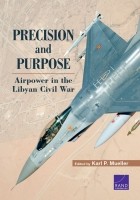| 来源类型 | Report
|
| 规范类型 | 报告
|
| 来源ID | RR-676-AF
|
| Precision and Purpose: Airpower in the Libyan Civil War |
| The RAND Corporation
|
| 发表日期 | 2015-07-08
|
| 出版年 | 2015
|
| 语种 | 英语
|
| 结论 | Airpower Prevented an Early Regime Victory- The air campaign enabled the opposition to survive Qaddafi's offensive in March 2011.
- Imposition of the no-fly zone and the continuation of coalition air strikes had a profound effect on the Libyan rebels beyond the protection those strikes provided from air and ground attacks.
Airpower Enabled Rebels to Go on the Offensive- Aerial intervention made possible not merely a victory against Qaddafi, but a Libyan victory.
- The availability of intelligence, surveillance and reconnaissance, especially of developed targets, was central to the conduct of the air campaign.
Intervention Was Done Cheaply and Effectively- No coalition personnel were killed, or even seriously wounded, carrying out operations over (or in) Libya.
- Target planners and aircrews generally succeeded in their considerable efforts to avoid civilian casualties.
- The war is estimated to have cost the coalition several billion dollars, a relatively low figure compared to other conflicts.
- Several nations' air forces were stretched to the limit of their abilities to sustain aircraft deployments.
Airpower Was Intertwined With Politics- The Libyan aerial intervention was unusual in having a rationale that explicitly revolved around a mandate to protect civilians.
- The Arab states' most important strategic contribution was in the political domain and in providing assistance to the Libyan rebels.
- The United Nations' endorsement of the intervention heavily influenced the participation of some countries.
- Applying the "Libya model" of using airpower to enable victories by indigenous ground forces to other settings is potentially powerful but will often be more difficult, especially where political conditions are less favorable than in Libya.
|
| 摘要 | Between March and October 2011, a coalition of North Atlantic Treaty Organization (NATO) member states and several partner nations waged a war against Muammar Qaddafi's Libyan regime that stemmed and then reversed the tide of Libya's civil war, preventing Qaddafi from crushing the nascent rebel movement seeking to overthrow his dictatorship and going on to enable opposition forces to prevail. The central element of this intervention was a relatively small multinational force's air campaign operating from NATO bases in several countries, as well as from a handful of aircraft carriers and amphibious ships in the Mediterranean Sea. The study details each country's contribution to that air campaign, examining such issues as the limits of airpower and coordination among nations. It also explores whether the Libyan experience offers a potential model for the future. |
| 目录 |
Chapter One
Examining the Air Campaign in Libya
Karl P. Mueller
Chapter Two
Strategic and Political Overview of the Intervention
Christopher S. Chivvis
Chapter Three
The Libyan Experience
Frederic Wehrey
Chapter Four
The U.S. Experience: National Strategy and Campaign Support
Robert C. Owen
Chapter Five
The U.S. Experience: Operational
Deborah C. Kidwell
Chapter Six
The British Experience: Operation Ellamy
Christina Goulter
Chapter Seven
The French Experience: Sarkozy's War?
Camille Grand
Chapter Eight
The Italian Experience: Pivotal and Underestimated
Gregory Alegi
Chapter Nine
The Canadian Experience: Operation Mobile
Richard O. Mayne
Chapter Ten
The Belgian, Danish, Dutch, and Norwegian Experiences
Christian F. Anrig
Chapter Eleven
The Swedish Experience: Overcoming the Non–NATO-Member Conundrum
Robert Egnell
Chapter Twelve
The Arab States' Experiences
Bruce R. Nardulli
Chapter Thirteen
Victory Through (Not By) Airpower
Karl P. Mueller
Appendix A
Timeline of Events in Libya
Appendix B
Air Order of Battle
|
| 主题 | Air Warfare
; Belgium
; Canada
; Denmark
; France
; Italy
; Libya
; Military Airlift
; Military Force Deployment
; Netherlands
; North Atlantic Treaty Organization
; Norway
; Qatar
; Sweden
; United Arab Emirates
; United Kingdom
; United States Air Force
|
| URL | https://www.rand.org/pubs/research_reports/RR676.html
|
| 来源智库 | RAND Corporation (United States)
|
| 资源类型 | 智库出版物
|
| 条目标识符 | http://119.78.100.153/handle/2XGU8XDN/522794
|
推荐引用方式
GB/T 7714 |
The RAND Corporation. Precision and Purpose: Airpower in the Libyan Civil War. 2015.
|
|
文件名:
|
RAND_RR676.pdf
|
|
格式:
|
Adobe PDF
|
|
文件名:
|
1495316284536.jpg
|
|
格式:
|
JPEG
|

除非特别说明,本系统中所有内容都受版权保护,并保留所有权利。
